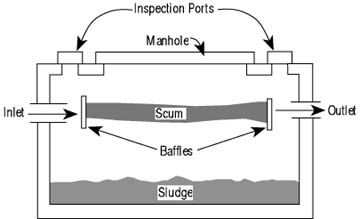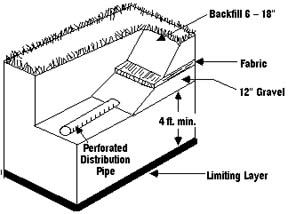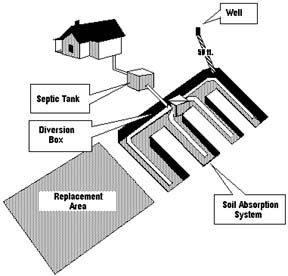
Above : Cross section of a septic tank
Soil Absorption System
The soil absorption system receives effluent from the septic tank and filters and treats the effluent before it enters the groundwater. At least 4 feet of unsaturated soil beneath the soil absorption system is needed to renovate wastewater before it reaches a limiting layer. A limiting layer may be bedrock, an impervious soil layer or the seasonal high water table.
The soil absorption system is a set of trenches 18 to 30 inches deep, at least 8 inches wide, and placed at least 6 feet apart. The maximum length of a trench is 150 feet. The bottom of these trenches must be level; construct them to follow the contours of the lot.
The bottom of each trench is filled with 6 inches of clean gravel. A 4-inch perforated pipe is placed on top of the gravel and covered with 2 more inches of gravel. The top of the gravel is covered with synthetic building fabric before the trench is backfilled with native cover soil. This prevents the soil particles from moving down into the gravel. Two inches of straw or a layer of untreated building paper are still sometimes used in place of the fabric. The cover soil should be mounded to account for settling, graded to avoid ponding of rainwater, and seeded with grass to prevent erosion.
The size of a soil absorption system is based on the size of the house and the percolation rate of the soil. For a three-bedroom home the yard area needed for the absorption system could range from 4400 ft2 for a soil percolation rate of 3 minutes per inch to 9000 ft2 for a soil percolation rate of 60 minutes per inch. This provides only the minimum area for the soil absorption system and the required replacement area. The set-backs from the water supply, lot lines, and drainage lines must also be taken into account.

Figure 2. Trench soil absorption system
Wastewater Distribution
In Hawaii, the soil absorption system is divided into two equal sections. A diversion device is used to alternate the flow of wastewater from one side of the system to the other. The diversion device should be easily accessible for annual switching.
Things to Watch Out For
Keep heavy equipment off the soil absorption system area both before and after construction. Soil compaction can result in premature failure of the system.
Divert rainwater from building roofs and paved areas away from the soil absorption system. This surface water can increase the amount of water the soil has to absorb and cause premature failure.
Make sure the alternating device and the trench bottoms are level to provide even distribution of the septic tank effluent. If settling and frost action cause shifting, part of the soil absorption system may be overloaded.
Avoid installing the septic tank and soil absorption system when the soil is wet. Construction in wet soil can cause puddling, smearing, and increased soil compaction. This can greatly reduce soil permeability and the life of a system.
Install water-saving devices. Water conservation can greatly reduce the amount of water going into the soil absorption system and extend its useful life.
Have the septic tank pumped and inspected regularly.

Figure 3. Soil absorption system with diversion box
Go to : Our Septic System













1 Comment
This comment has been removed by the author.
Posted on September 25, 2013 at 11:30 PM
Post a Comment